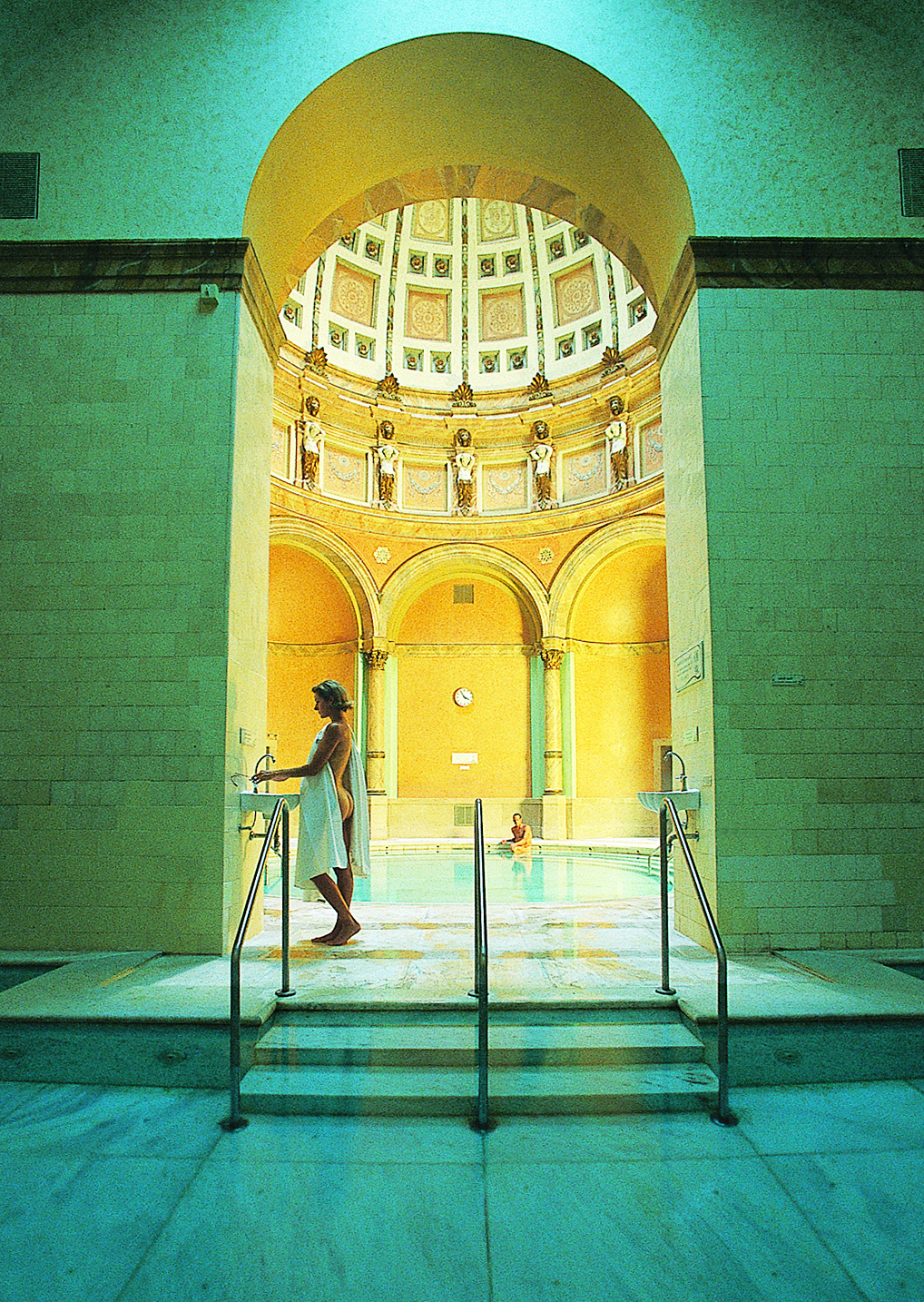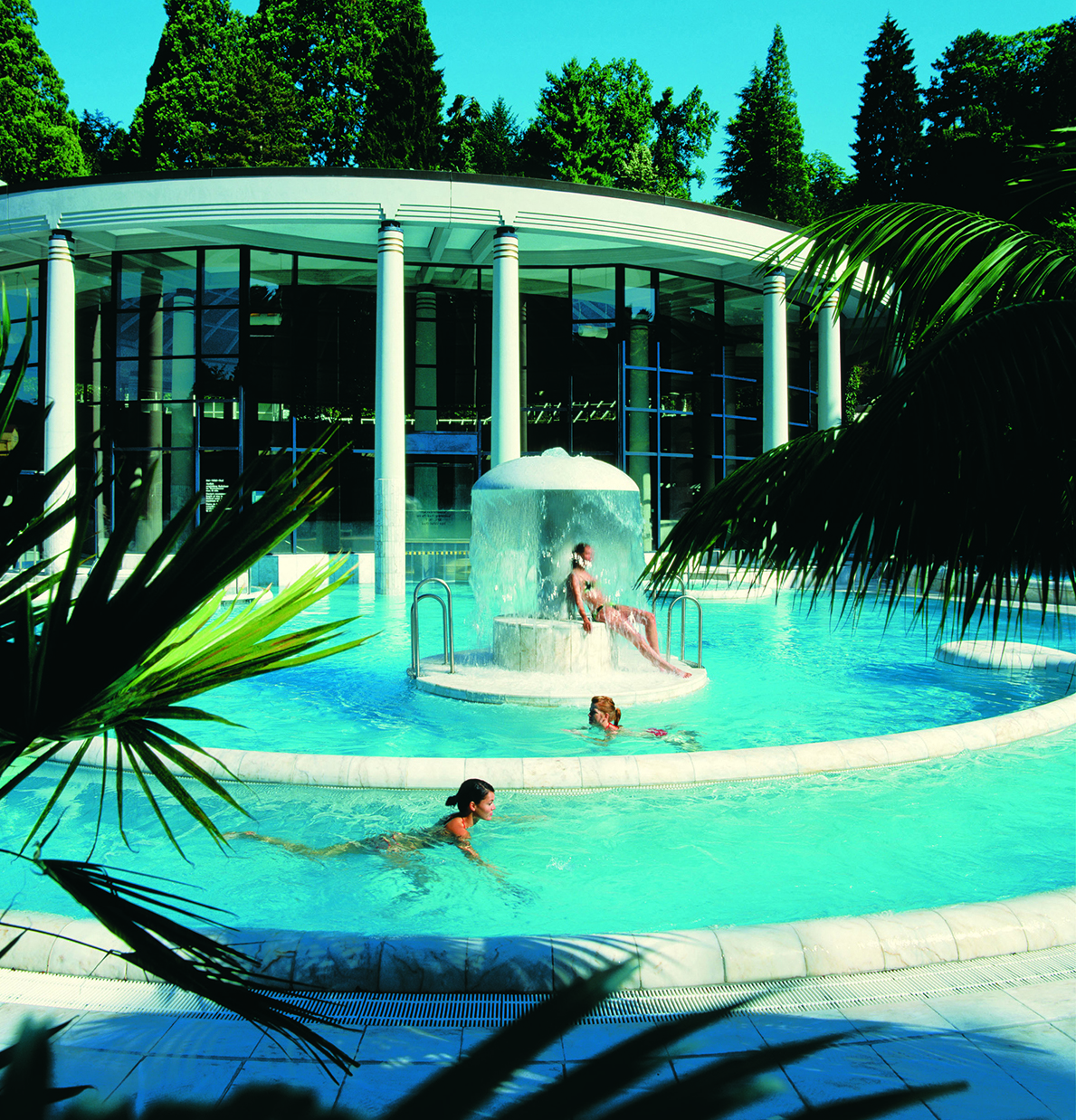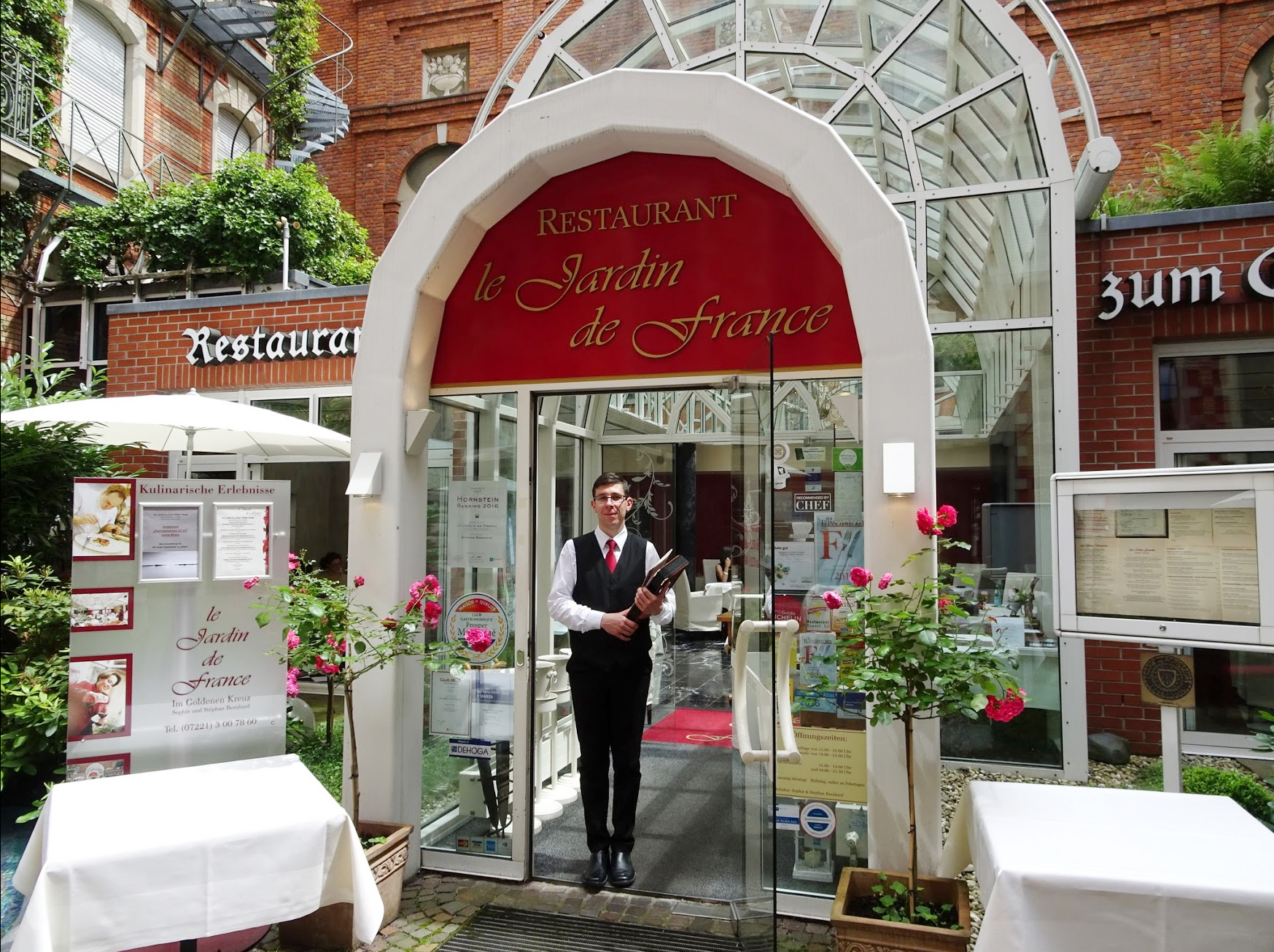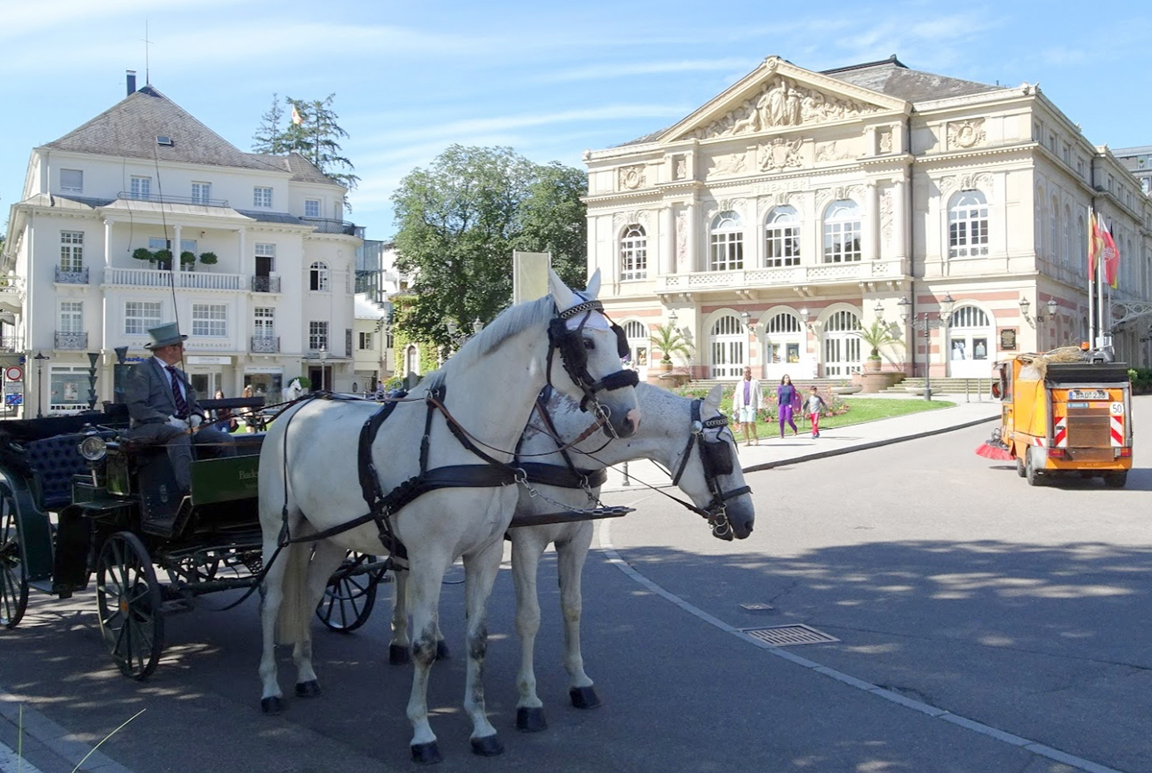
Immaculate streets and horse-drawn carriages augment the charm of Baden-Baden’s neo-baroque Theater, whose interiors were modeled after Paris’ Opera Garnier. Composer Hector Berlioz used to debut his operas here because he regarded the city as “a garden, an oasis, a paradise.”
Baden-Baden, the idyllic spa town at the foot of Germany’s Black Forest, draws spa-goers to its thermal waters and wine enthusiasts to its nearby vineyards. Walkers stroll the flower-dotted paths and hikers can trek up hills or attempt to summit the 2,191-ft Merkur Mountain.
The Romans discovered the thermal waters 2,000 years ago, as you can see in the open-air museum that displays the remnants of their baths. But the time that still resonates is the 1800s, when the town was the summer residence of French, German and Russian aristocrats and artists. Clara Schumann, the noted Romantic pianist who was wife to composer Robert Schumann, had a house here. Hector Berlioz composed and debuted an opera in the Theatre, modeled on the Paris Opera. Dosteyevsky and Turgenev spent time in this green and walkable town, with its impeccable 19th century neo-classic buildings, flowering trees, museums, shops and public gardens.
Then as now, the Linkenstaler Allee is the town’s grandest promenade. On one side, the river Oos and the town of shops, restaurants and steepled churches. On the other side, acres of grass, trees and flowers. In Ivan Turgenev’s spellbinding book, Smoke, this is where the ostentatious aristocrats would take their daily stroll. It is also where the hero walks, head down, pondering his doomed love. At one end of the Allee is the City Museum, which displays the history of Baden-Baden, from the Romans onwards. Yet the town is about the present as well as the past. The Frieder Burda Museum is a modern concrete and glass building that manages to fit right into the landscape. Designed by New York architect, Richard Meier, the museum houses over 1000 works of modern art, with rotating exhibits of major international artists.
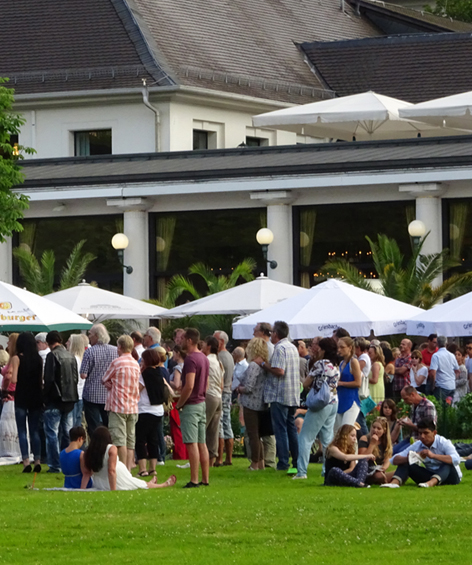
A free summer concert fueled by plenty of food and drink attracts locals and tourists alike to the lawn in front of the Kurhaus
Around the corner is the Kurhaus, one of Baden-Baden’s signature buildings. Dating from the l820’s, it looks like it must have looked then, with white pillars and a colonnade decorated with frescos.
In front is an elegant outdoor cafe. Beyond it there is plenty of space for music festivals and the Christmas market, for this is an all-season destination, with dramatic foliage in the fall, followed by cross-country skiing and cozy fireplaces in winter.
The Kurhaus has an indoor performance space, and so the sound track of my first day was the music of Brahms and Bruckner, courtesy of a free afternoon performance by the Baden-Baden Philharmonic. This was just a taste: The town is known for its grand Festspielhaus, Europe’s second largest concert hall, with A-list performers like the Berlin Philharmonic.
Perhaps the main lure of Kurhaus today is the Casino, which Marlene Dietrich called the most beautiful in the world. Here Dostoyevsky spent five weeks in 1867 gambling and losing, even pawning his young wife’s wedding ring. Critically in debt, he based his novel, The Gambler on the experience. The decor is Belle Époque excess, with gilt framed mirrors, crystal chandeliers, a red room inspired by Versailles, statues of cherubs, vermillion carpets, and roulette tables that have been spinning for 250 years.
Spas:
But casinos are not for everyone. What has always drawn most people to Baden-Baden are the spas.
The grand neo-Renaissance Friederichsbad spa, must have looked the same when it was built in 1877, with high domed ceilings and pale green tiles. A sign says that the spa building is heated thermally, just the way it has always been.
Here nudity rules – bathing suits are not permitted, but there are some ladies-only times. Whether or not you go on co-ed days, the routine is the same: you move from station to station, directed by the numbers on the wall, (thankfully, no English is required), the humorless attendants, and the signs that indicate how much time you should spend in each pool or sauna, with showers in between. With no clothes to indicate modern times, transported by the timeless and meditative atmosphere, I gazed at the domed ceilings and tiles decorated with peacocks and flower. The ritual has l6 steps, and if you take your time you could spend three hours here. The temperatures are calibrated to heat up and cool down the body, but there’s only one ice-cold pool and that is at the end. Then you go to a nap room that felt to me like a dorm in a Swiss boarding school.
Next door is the other major spa, Caracalla. Sleekly modern, with bathing suits required, the 4000 square foot family-friendly spa dazzles with 12 natural springs supplying a hot and cold rock grotto, whirlpools, waterfalls and water jets, both in and outdoors. There are hot and cold saunas and herb-infused steam rooms, with scents and the sounds of New Age music.
You can sign up for massages and facials, but bathing seems to be point here, just as it has always been in traditional spas.
For a facial, I head to the town’s legendary hotel, the 140-year old Brenners Park-Hotel and Spa. If Baden-Baden has a grand hotel, this is it. When the French forces established their headquarters in Baden-Baden in 1944, they requisitioned the hotel. When President Charles de Gaulle and German Chancellor Konrad Adenauer met in 1962 to discuss the unification of Europe, they met here.
Its expanded spa facility is now located next door in Villa Stephanie, once the residence of Stephanie de Beauharnais, Duchess of Baden and adoptive daughter of Napoleon I. My 80-minute, multi-step facial includes everything from aromatherapy to massage, and leaves me feeling aglow. The extensive spa menu offers massages, wraps, as well as personal trainers, including cyclists who will take you on the biking and hiking trails of the Black Forest just beyond. You could stay at the Villa Stephanie and have a wellness assessment, complete with special meals.
The spacious luxe atmosphere, with terraces overlooking the gardens, is part of the treatment. I mused as I swam in an azure indoor pool.
And then lunch, and that other renowned liquid known for its relaxing properties: wine. It’s not surprising that Baden-Baden, with its museums, concerts halls and restaurants, would be a wine place rather than a beer place.
Baden, which includes the town of Baden-Baden, happens to be the third-largest wine growing area in Germany. This warmest part of the country is likened to Burgundy, and the wine growing region extends for 400 km (200 miles) along the Rhine. There are high-quality vineyards just outside of town, carved out of the mountainous Black Forest. They specialize in Riesling and Pinots – blanc, gris, and noir. The latter have been basking in sunshine and glory, wining contests and accolades for the past decade.
Sitting on the terrace of the Wintergarten, Brenners’ casual restaurant facing the Lichtentaler Allee, I order a local Pinot blanc, which is really a white Burgundy, to go with my first course of celeriac tart with truffle crumble, balsamic pine nut reduction and ragout of beans and tomato. Then a Riesling to match the Riesling froth on my seared filet of pike-perch, cauliflower and lentils and parsley potatoes. The dishes are impressive, and this isn’t even the two Michelin star dinner restaurants next door, where I spot the young star chef, Paul Stradner, designing the evening menu.
When it comes to restaurants, the Baden area is star-studded. The Jardin de France earned its Michelin star fifteen years ago, and chef Stephan Bernhard and his wife Sophie, run the place with an emphasis on the authentic. “We don’t follow fads”, says the native of Alsace, just over the French border. I was sitting outside in a large courtyard with – of course – a gurgling fountain. (In Baden-Baden, even the bookstore has a water feature). Chef Bernhard’s wine-list includes Baden wines, and he has high praise for the local Pinot noirs. He suggested a Riesling to go with my tuna tartare starter – he likes it because it is light and minerally – and once again I have a new appreciation for the range of Rieslings.
What to do next? There are lots of physical activities, from hiking to golf, parasailing to cycling. I chose a no-fail way of discovering any bustling town or city: shopping. There are glitzy international brands of clothes and handbags and jewellery to remind you that some people really do win at Roulette. And shop-owners who speak German first and often Russian second. The Russian presence started with the Tsars and resumed after the fall of the Soviet Union and the rise of big money. It has declined today due to the fall in the ruble.
In Baden-Baden, shopping is made more pleasant because you can walk to the major shopping districts. What appealed to me were the stores with wearable, mid-price German brands I had never heard of. And shoe stores with German brands I recognized. Pharmacies are everywhere, with lots of homeopathic remedies and French skin-care lines. It all seems part of the cure that is Baden-Baden.
Restaurants: The bar is high here, so it goes without saying that restaurants use local produce whenever possible. There are Michelin-starred eateries, cafes and traditional beer gardens.
Le Jardin de France, Lichtentaler Strasse 13, Baden-Baden. With one Michelin star, the restaurant serves traditional French cuisine, lighter in summer.
Weinstube Badreit, Kuferstrasse 3, 76530 Baden-Baden, 7221 23 136 (no website). A favourite with the locals, this moderately priced restaurant is in an ivy-covered courtyard tucked away off a narrow street. Try the duck foie gras on walnut bread with lettuce dressed in a cherry balsamic. And do not miss the Mauftachen, a large ravioli dumpling stuffed with meat and spinach in a bath of herbed bouillon.
Brenners Park-Restaurant, Schillerstrasse 4/6 Baden-Baden 7221 900890. With two Michelin stars, this restaurant – and it’s neighbour, the Wintergarten – offers fine cuisine in an elegant atmosphere facing the Lichtentaler Allee.
Cafe Koenig 12 Lichtentaler Strasse 7221 23573. Franz Liszt and Leo Tolstoy were customers in this charming cafe that has been around for 250 years. The chocolate counter sells all manner of delectables, from truffles to chocolate covered nuts.
Weingut Schloss Neuweier, Less than 20 minutes by cab from Baden-Baden, this terraced winery welcomes visitors to its tasting rooms and wine cellar dating from 1610. Owner and director, Robert Schatzle is especially proud of his Maurwein, or wall wine, where the wall of granite and volcanic ash combines to give the wine a fine mineral quality as well as notes of citrus and tropical fruit.
Schatzle has traveled the world, and thinks his wines are competitive. “We didn’t realize what we had, but the prejudices against German wines is lower now.” On the verdant grounds is a 12th century castle, renovated most recently in 2005 and hosting overnight guests and diners. A decade ago the restaurant earned a Michelin star.
Most of Baden Baden’s attractions are closed at the moment, but when the town opens – they are talking about mid-June – there will be al fresco dining and grand hotels, concerts and museums and some of the best thermal spas in Europe. Also, for those eager to once again experience the outdoors, there are hiking paths, ballooning and visits to local wineries. People will return. That’s the way it is with a classic.
Some of the events already listed are the July International Vintage Car rally and the food and music festival in front of the 1820 vintage Kurhuas. The annual International Horse Racing festival, complete with women dressed in “fascinator” hats is scheduled for August 6. Among the many winter activities is the Christmas Market, opening at the end of November.
On the health front, Germany, with a population of 83 million, has one of the best-funded health systems in world. It has not been spared the Corona virus – as of mid April over 62,500 were infected. Yet 91% of those experienced mild to moderate symptoms, and 21,400 had recovered. What has caused health analysts to take note is the small number of deaths – 1,097.
Spain, by contrast has 73,399 currently infected patients and 10,096 deaths.
The low death rate in Germany is attributed to several factors. First, the system has 25,000 ventilators and an abundance of protective equipment. This might change, of course, as the pandemic peaks. Also, Germany is a champion at testing. Close to one million people have been tested, and the country has the capacity to take up to a half-million samples per week. As it happens, the February skiing season draws young, healthy Germans to Italian slopes. It was a bad time to go to Italy, but young and middle-aged skiiers are just the people with the capacity to heal.
Hotels:
Hotel Dorint Maison Messmer, Werdestr.1, 7221 301 20. Now called Maison Messmer Baden-Baden, this elegant hotel’s rooms were completely renovated in 2019. The super location is across from the Casino and Theatre and around the corner from the Lichtentaler Allee
Heliopark Bad-Hotel zum Hirsch, Hirschstrasse 1, phone 72 21 9390. Records show this operated as a hostel and bathhouse in the 1300’s. Renovated through the centuries, it strikes an ideal balance between its Art Nouveau interiors and up-to-date amenities like free WiFi. The Heliopark is one of only two hotels in town to have a tap for the town’s thermal water – in this case it is in the large bath tub. And the two large spas are less than a ten-minute walk away.
What’s New:
One of Baden-Baden’s most endearing attractions, the funicular that goes up to Mount Merkur has been renovated. The retro design remains, but now the cars are accessible to people with limited mobiity. And on top of Mount Merkur is a new restaurant, Merkurstueble
The grand Brenners Parkhotel and Spa has a new restaurant called Fritz and Felix.![]()
_________
Jacqueline Swartz work appears in major Canadian publications. She has written for Agence-France Presse, Cosmopolitan and Conde Nast Traveler in the UK. Travel writing encompasses her interests and passions, from architecture to food, from health to archaeology.![]()


